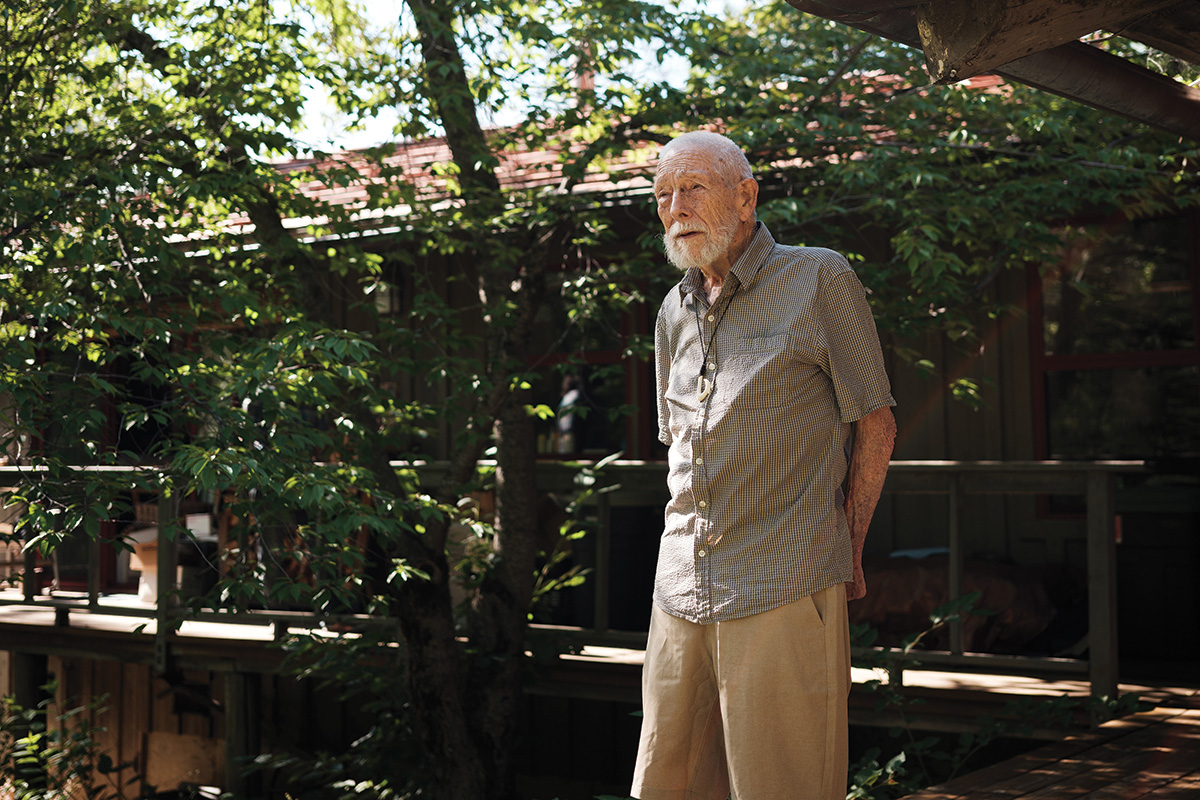An Anthology of Disruptions, Large and Small
Library of America honors poet Gary Snyder ’51 with volume of his collected poems.
Good poetry is meant to be disruptive. Subversive and indigestible, it enters the cultural bloodstream as a corrosive irritant. Resistant to containment and mass assimilation, it endures on its own terms like the timeless verses of Shakespeare.
So declared Kenneth Rexroth, leader of the San Francisco Renaissance literary movement. In the early 1950s, he welcomed into his North Beach circle three aspiring poets fresh out of Reed College— Lew Welch ’50, Philip Whalen ’51, and Gary Snyder ’51. Under Rexroth’s tutelage, the trio began waging their own poetic assaults on America’s post-war materialistic appetite.
Crossing paths with Allen Ginsberg and Jack Kerouac, they found themselves earmarked as the Beat movement’s West Coast wing. It was a pigeonhole Snyder, for one, sought to evade. By the time the movement morphed into the innocuous beatniks, he had embarked upon a 10-year sojourn to Japan, immersing himself in Zen Buddhism, haiku, and Chinese poetry.
Combining those Asian influences with his undergraduate studies in the classics, modern literature, anthropology, and Native American mythology, Snyder was able to forge a fresh and original way of looking at the world, one that fostered one of the most singular and distinctive voices in modern poetry.
Last year, the 93-year-old Snyder was honored by the Library of America, who published his collected poems in their preeminent book series of prominent poets and writers. In celebration, a tribute was held, featuring testimonies from various distinguished literati.
After expressing his gratitude for the accolades, Snyder pointed out that his social anarchism, which views liberty and social equality as interrelated, had been largely overlooked. Its influence on his work, he said, was “not quite unspoken but very subtle often, or simply assumed in directions and spirits.”
It was a gentle reminder that there is nothing safe about a Gary Snyder poem.
Beneath the common speech-patterns and close, intimate attention to natural imagery, his poems elicit a complex interaction, resonating with the reader, consciously or unconsciously, on multiple levels. That Coyote—the slippery, wily trickster who warily keeps his distance from civilization—was a favorite Native American archetype during his studies at Reed should come as no surprise.
The allure of Snyder’s poetry begins with the language itself. He cites Ezra Pound, a strong lyricist with an ear for words, as the first poet to truly speak to him. Similarly, Snyder’s cadence is crisp and clear. He lays down familiar terms in unfamiliar juxtapositions with rhythms borrowed from hand work. The approach is spelled out in his poem “Riprap,” a term he defines as “a cobble of stone laid on steep, slick rock to make a trail.”
Lay down these words
Before your mind like rocks.
placed solid, by hands.
In choice of place, set
Before the body of the mind
in space and time:
Solidity of bark, leaf, or wall
riprap of things
The “things” in a Snyder poem are largely drawn from the physical landscape. Finely distilled, they radiate a translucency easily mistaken for simplicity. But beneath their surface simplicity lies a terrain of unsettling depths, as in the poem “Piute Creek,” where a panorama suddenly coalesces with deep time:
Hill beyond hill, folded and twisted
Tough trees crammed
In thin stone fractures
A huge moon on it all, is too much.
The mind wanders. A million
Summers, night air still and the rocks
Warm. Sky over endless mountains.
All the junk that goes with being human
Drops away, hard rock wavers
After returning from Japan in the mid-’60s, Snyder settled with his wife and two children among a community of back-to-the-land Zen aficionados in the Sierra foothills. As his general focus shifted to being rooted in place, his poetry became stylistically more emotional, metaphoric, and lyrical. It also gained relevance among those increasingly concerned with the natural world.
Because Snyder’s views are often so nuanced, drawing from a wide range of references with a timescale extending back 10,000 years, it’s possible for various schools of thought to adopt him as their own. Hence, his popular designation as “poet laureate of deep ecology.” As an environmental movement, deep ecology seeks freedom from the dichotomy of human civilization and nature by viewing humans as equal and interconnected with all other forms of life.
But Snyder is not so easily packaged. The trail he lays out toward such freedom ultimately leads into the wilds of Zen impermanence and emptiness.
“To be truly free,” he writes, “one must take on the basic conditions as they are—painful, impermanent, open, imperfect—and then be grateful for impermanence and the freedom it grants us . . . The world is nature, and in the long run inevitably wild, because the wild, as the process and essence of nature, is also an ordering of impermanence.”
His poem “Ripples on the Surface” points to the trail’s end.
The vast wild
the house, alone.
The little house in the wild,
the wild in the house.
Both forgotten.
No nature
Both together, one big, empty house.
Tags: Alumni, Awards & Achievements, Books, Film, Music, Editor's Picks, Reed History
